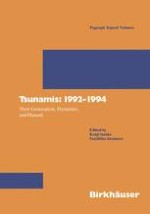1995 | OriginalPaper | Buchkapitel
Numerical Simulation of the 1992 Flores Tsunami: Interpretation of Tsunami Phenomena in Northeastern Flores Island and Damage at Babi Island
verfasst von : Fumihiko Imamura, Edison Gica, Tomoyuki Takahashi, Nobuo Shuto
Erschienen in: Tsunamis: 1992–1994
Verlag: Birkhäuser Basel
Enthalten in: Professional Book Archive
Aktivieren Sie unsere intelligente Suche, um passende Fachinhalte oder Patente zu finden.
Wählen Sie Textabschnitte aus um mit Künstlicher Intelligenz passenden Patente zu finden. powered by
Markieren Sie Textabschnitte, um KI-gestützt weitere passende Inhalte zu finden. powered by
Numerical analysis of the 1992 Flores Island, Indonesia earthquake tsunami is carried out with the composite fault model consisting of two different slip values. Computed results show good agreement with the measured runup heights in the northeastern part of Flores Island, except for those in the southern shore of Hading Bay and at Riangkroko. The landslides in the southern part of Hading Bay could generate local tsunamis of more than 10m. The circular-arc slip model proposed in this study for wave generation due to landslides shows better results than the subsidence model, It is, however, difficult to reproduce the tsunami runup height of 26.2 m at Riangkroko, which was extraordinarily high compared to other places. The wave propagation process on a sea bottom with a steep slope, as well as landslides, may be the cause of the amplification of tsunami at Riangkroko. The simulation model demonstrates that the reflected wave along the northeastern shore of Flores Island, accompanying a high hydraulic pressure, could be the main cause of severe damage in the southern coast of Babi Island.
